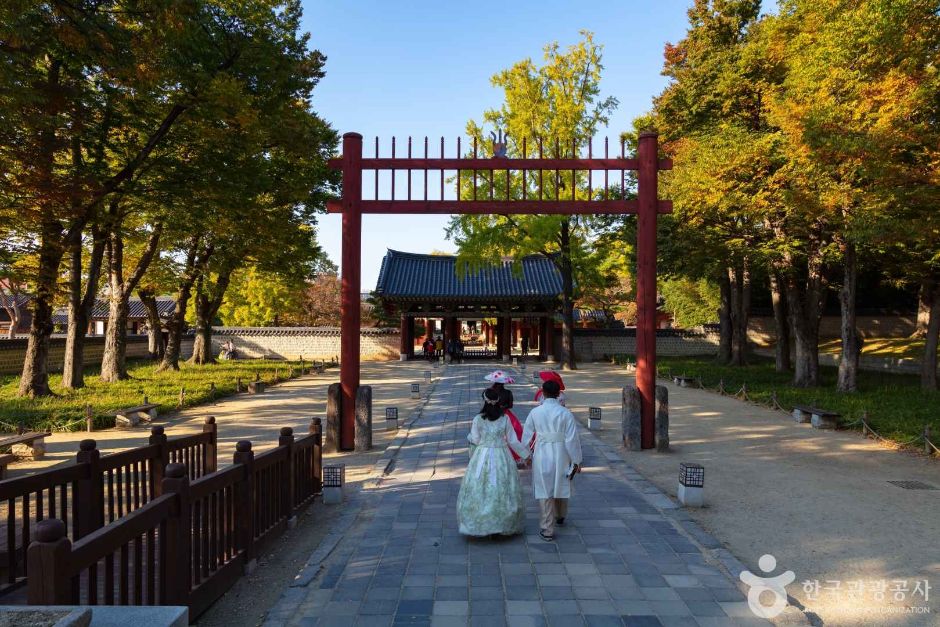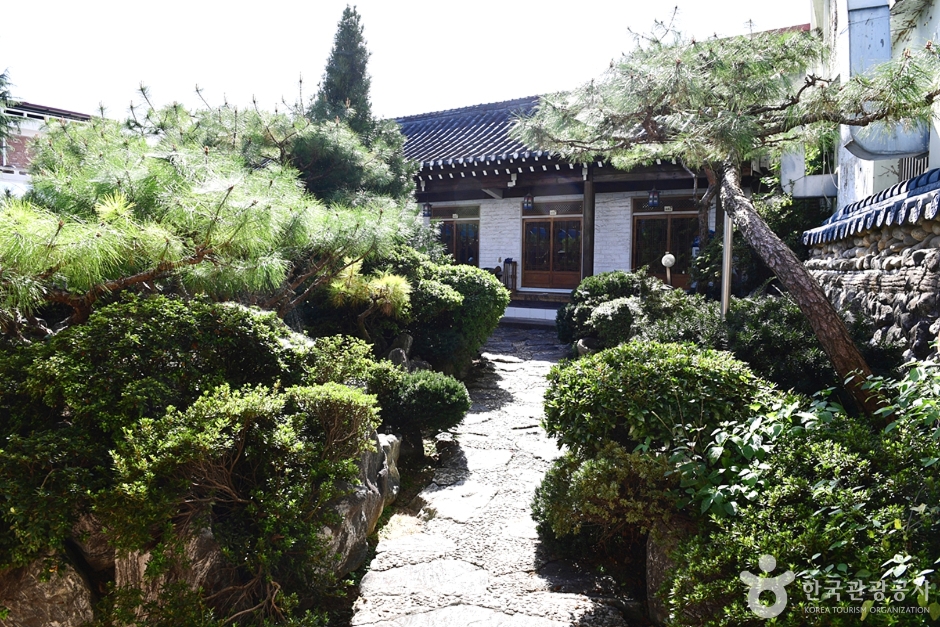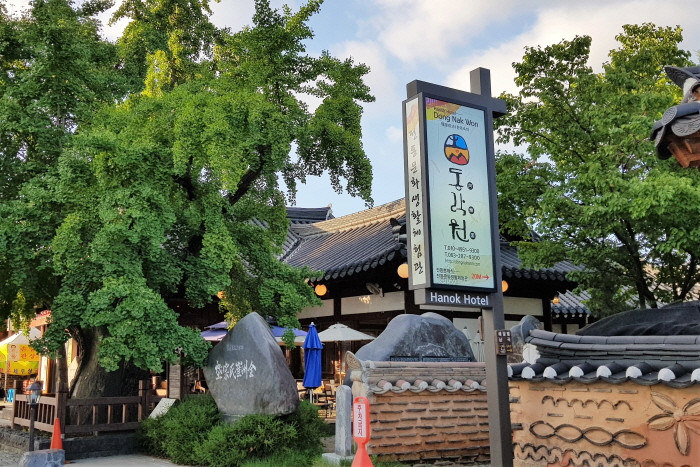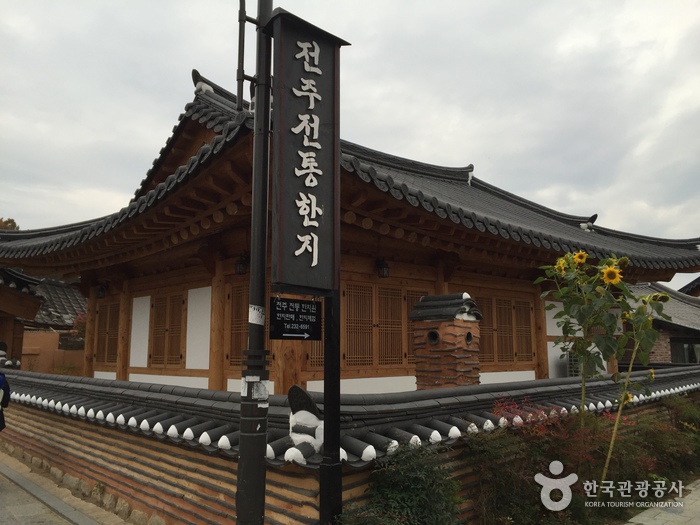Sky [Korea Quality] / 하늘애 [한국관광 품질인증]
218.0M 2024-04-07
33-11, Dongmun-gil, Wansan-gu, Jeonju-si, Jeonbuk-do
+82-10-6453-1200
Sky is a guesthouse located in an alley next to the Jeonju Hanok Village Parking Lot. The house was built in 1930 and remodeled in 2014. It was originally a Japanese-style house, but the original building was completely demolished and a traditional Korean house was built in its place. The sheets and blankets in all the guestrooms are embroidered by the owner of the guesthouse. Her embroidery skills make some of the guests choose to stay at this guesthouse since they can learn the trade from her. She offers an embroidery class for such guests for only KRW 4,000 per person, and only 5 people are allowed in the class. If you want, you can also play the traditional Korean game called "yutnori" for free.
Museo de Licor Tradicional de Jeonju (전주 전통술박물관)
229.0M 2024-05-07
Hanji-gil 74, Wansan-gu, Jeonju-si, Jeonbuk-do.
El museo desea recuperar los métodos tradicionales de producción del licor que se adecúe al estilo actual. Para cumplir esta meta, establece clases llevadas a cabo por maestros quienes revelan sus secretos de elaboración del licor, y, de esta manera, los visitantes podrán preparar su propio licor casero. También trata de difundir la cultura tradicional de tomar el licor, elegantemente, como la costumbre que tenían los antepasados. En particular, el museo también se esfuerza para promocionar y propagar el licor tradicional de Corea, de tal manera que establece eventos y festivales periódicamente. Además, los turistas extranjeros que visiten la ciudad de Jeonju tendrán la oportunidad de degustar el licor en este museo.
Aldea Tradicional de Jeonju (Cittaslow) (전북 전주 한옥마을 [슬로시티])
259.4M 2025-07-09
Girin-daero 99, Wansan-gu, Jeonju-si, Jeonbuk-do.
La Aldea Tradicional de Jeonju (Hanok Maeul) está ubicada en las zonas de Pungnam-dong y Gyo-dong. En esta área se encuentran concentradas aproximadamente 800 casas tradicionales de Corea, las hanok. Este lugar es famoso por conservar intacto el estilo tradicional, proporcionando la oportunidad de disfrutar el ambiente antiguo y folclórico del país.
Lo más elegante de esta aldea es seguramente el estilo de los techos de las hanok. La peculiaridad de esta vivienda es que el borde de los techos está ligeramente dirigido hacia el cielo. La estructura de estas casas se divide en dos secciones: anchae y sarangchae. Anchae, siendo el lugar donde permanecen las mujeres, también es llamado gyusubang; mientras que el sarangchae es el lugar utilizado por los hombres, también llamado seonbibang. La construcción arquitectónica diferencia el sector destinado a los hombres y mujeres. De tal manera, el anchae, por ser el lugar donde residen las mujeres, se localiza en la parte más resguardada y silenciosa de la casa.
Otra característica es que los cuartos son de ondol, un sistema de calefacción instalado en el suelo. La estructura del ondol es bastante simple, consiste en aplicar el sistema de calefacción debajo del piso, con pasajes horizontales para el humo y una chimenea vertical para el escape. Una de las grandes ventajas es que en verano es fresco y en invierno, caliente.
Además de los recorridos, observando la sabiduría y las costumbres tradicionales de la antigüedad, otro de los atractivos lo componen las actividades culturales que consisten en experimentar las habitaciones de ondol y degustar del plato típico famoso de la ciudad, el bibimbap (arroz mezclado con surtido de vegetales).
Santuario Gyeonggijeon (경기전)
262.8M 2025-07-09
Taejo-44, Wansan-gu, Jeonju-si, Jeonbuk-do.
El Santuario Gyeonggijeon fue fundado en 1410 y es donde se guarda el retrato del rey Lee Taejo, el fundador de la dinastía de Joseon, dibujado en Jeonju, Gyeongju y Pyongyang. La estructura fue parcialmente destruida durante la Guerra de Imjin de 1592 a 1598. La estructura actual fue reconstruida en 1614.
Hankookjib (한국집)
264.4M 2025-07-09
119, Eojin-gil, Wansan-gu, Jeonju-si, Jeonbuk-do
Hankookjib literally means 'Korean house.' The restaurant serves Jeonju bibimbap, kongnamul haejangguk (spicy bean sprout soup), sagol gomtang (thick beef bone soup), doenjang jjigae (soybean paste stew), and samgyetang (ginseng chicken soup). Many well-known figures, including former presidents of Korea, have been sited as enjoying the authentic Jeonju bibimbap here.
Dong Nak Won / 동락원
277.5M 2025-03-05
33-6, Eunhaeng-ro, Wansan-gu, Jeonju-si, Jeonbuk-do
+82-63-287-9300
Hanok Hotel Dongrakwon used to be a memorial hall for Missionary M. Junkin who worked in Jeonju in 1985, and had long been used as an official residence for the Bank of Korea. The 100-year-old Hanok retains the history and culture that modern hotels do not have. Since the renovation to make it a hanok hotel, it is now utilized as a space for traditional music performances, traditional weddings, or small weddings. The entire building can be rented for various gatherings, seminars, conferences, family events, and so on. The beauty of a hanok is found in every corner of Dongrakwon such as the wide lawn, the pond in front of Sarangchae, and the jar stand next to Anchae. The antique furniture and folding screen in the rooms have been used for generations, enabling guests of the hanok to time travel to 50-100 years ago.
The yard is a great place to play simple Korean traditional plays such as Jegichagi and Dakjichiji, whereas the free-of-charge red clay sauna will relieve fatigue. The outdoor hot / cold bath and sun bath site is a new addition to Dongrakwon.
There is a 600-year-old Ginkgo tree standing on the Eunhang-ro, where the accommodation is located. Opposite the alley is Donghak Revolution Memorial Exhibition Hall; Gyeonggijeon East Gate is 200m away. The hotel is close to Taejo-ro, the busiest street of Jeonju Hanok Village; neighboring Eunhang-ro, Choi Myeong Hee-gil, and Eojin-gil all retain the unique quietness and beauty of Hanok Village. It will be also nice to ride on the mountain bike that Dongrakwon offers free of charge in order for guests to visit corners of the Hanok Village, or ride along the Jeonjucheon Stream.
Centro Tradicional del Hanji en Jeonju (전주전통한지원)
279.6M 2024-04-07
Hanji-gil 100-10, Wansan-gu, Jeonju-si, Jeonbuk-do
Jeonju ha sido el mayor productor de papel tradicional hanji durante más de cien años. Aún mantiene esta orgullosa tradición y el Centro Tradicional del Hanji pretende preservar las técnicas tradicionales de fabricación de papel y ser el centro de la industria del hanji. Más del 80 por ciento del papel producido en el centro es exportado a Japón, y el resto se usa en Corea. El centro produce, expone y vende hanji para caligrafía, pinturas orientales y otros elementos artesanales.
Jeonju hanok house [Korea Quality] / 전주한옥숙박체험관 [한국관광 품질인증]
288.3M 2024-04-07
56-1, Eunhaeng-ro, Wansan-gu, Jeonju-si, Jeonbuk-do
+82-10-3659-0055
Jeonjuhanok Korean House is a traditional Korean house built more than 60 years age, and it was recently remodeled for visitors to see and experience an old traditional Korean house. It’s conveniently located on the street called "Eunhaeng-ro" right in the middle of Jeonju Hanok Village for those visiting the area to take a tour of the hanok village. Although it's in the middle of the village, it's quiet inside because it's located at the end of a long, wide alley, which has the feel of an art gallery thanks to the lighting. There is a table in the yard in front of the ‘ㄱ’-shaped house. Behind the house is a café where breakfast is served. The house has an open space between the rooms called "toetmaru", which serves as a living room as in all traditional Korean houses. It’s where Koreans used to rest under the warm sunlight in the old days. The guests must pass through this "toetmaru" to get to the roms.
Jeonjuhanok Korean House has seven "ondol (floor-heated)” rooms with a loft. The rooms are clean and have a simple interior with a wooden ladder to the loft, which is a favorite place for most kids staying here with their parents. Each guestroom is furnished with a water purifier. The guesthouse serves toast, caffe Americano, fruits, and tea for breakfast.
Ihwa Gotaek [Korea Quality] / 이화고택 [한국관광 품질인증/Korea Quality]
292.4M 2024-10-15
91, Hanji-gil, Wansan-gu, Jeonju-si, Jeonbuk-do
This “ㄱ”-shaped hanok (traditional Korean house) building, standing to the right-hand side of the gate, is an old house with a history of more than 120 years that was transplanted to its present site from its original location in Buan’s local Confucian school in Jeollabuk-do. The building to the left across the courtyard is a “ㄷ”-shaped building with a history of about 70 years. The buildings at Ihwa Gotaek stick to the classics of hanok architecture, featuring the trio of open wooden-floor spaces called numaru, toenmaru, and jjongmaru.
There are 8 rooms in total, 1 four-person room with eight maximum occupancy, and 7 two-person rooms with maximum occupancy of four. All rooms have their own attached restrooms. Guests are served with complimentary seasonal refreshments, either a sweet rice punch (sikhye) or shaved ice with sweetened red beans (pat bingsu) made in-house, and for breakfast guests have a wonderful spread that includes bibimbap, rice cake soup, black sesame porridge, and bean-powder-coated rice cake, served in traditional bronze tableware. Guests can also place their reservations for traditional cultural programs like pansori (epic chant), tea ceremony, natural dye, and Korean paper art, and enjoy a discount of 30% in hanbok (traditional Korean clothes) rental.
GaEunChae 2 (가은채2)
303.3M 2025-07-10
100-20, Hanji-gil, Wansan-gu, Jeonju-si, Jeonbuk-do
Gaeunchae 2 is the sister hanok of Gaeunchae in Jeonju Hanok Village, Jeollabuk-do. It’s a traditional red clay-walled hanok with ondol underfloor heating, exposed roof beams and hanji wallpaper and flooring - creating a beautiful and distinctive hanok interior. It has a small hallway which is good for storing luggage or just to sit and chat. In the garden are sculpted stone lanterns and tigers. Local attractions such as Jeondong Cathedral and Gyeonggijeon Shrine are a short walk away.
![Sky [Korea Quality] / 하늘애 [한국관광 품질인증]](http://tong.visitkorea.or.kr/cms/resource/39/2046939_image2_1.jpg)

![Aldea Tradicional de Jeonju (Cittaslow) (전북 전주 한옥마을 [슬로시티])](http://tong.visitkorea.or.kr/cms/resource/50/3479250_image2_1.jpg)




![Jeonju hanok house [Korea Quality] / 전주한옥숙박체험관 [한국관광 품질인증]](http://tong.visitkorea.or.kr/cms/resource/90/2531490_image2_1.jpg)
![Ihwa Gotaek [Korea Quality] / 이화고택 [한국관광 품질인증/Korea Quality]](http://tong.visitkorea.or.kr/cms/resource/50/2707550_image2_1.jpg)
 Español
Español
 한국어
한국어 English
English 日本語
日本語 中文(简体)
中文(简体) Deutsch
Deutsch Français
Français Русский
Русский